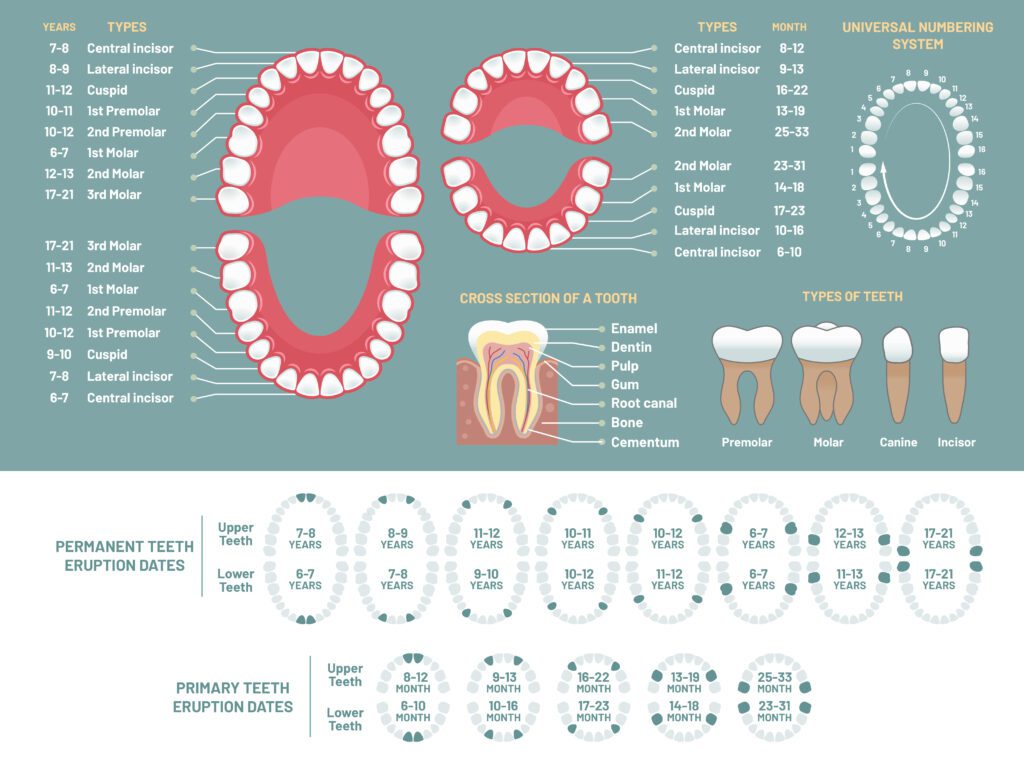You’re not alone if you’ve ever wondered about the different numbers assigned to your teeth during a dental examination. Understanding the tooth chart with numbers and letters is analytic for vocal health. Interpreting the tooth numbers chart can help you communicate beneficially with your dentist and give important perceptions of your verbal health. A tooth numbering system qualifies for simple recognition, communication, and dental report management.

There are various distinct tooth numbering schemes used around the world.
The Numbering System
In dental charts, each tooth is assigned a unique number. The mouth is divided into quadrants containing teeth labeled from 1 to 8. The numbering system streamlines the identifying individual teeth, making it easier for dentists to discuss patients’ cases.
The Lettering System
In addition to numbers, some dental charts utilize letters to indicate primary teeth. Letters such as “A” to “T” are assigned to primary teeth, providing a clear distinction from permanent teeth.
1. Introduction to Tooth Numbers Chart
The tooth numbers chart is a visual representation used by dental professionals to identify each tooth in your mouth uniquely. Dental professionals will need this chart to communicate, identify, and manage issues more effectively when providing vocal health care.
2. The Importance of Tooth Numbering
Tooth numbering serves as a standardized way to refer to specific teeth. This is crucial because referring to teeth by position is more accurate than using common names, which can vary by region and language.
3. Deciphering the Universal Numbering System (UNS)
The Universal Numbering System assigns a unique number to each tooth, with the upper right third molar designated as one and numbering clockwise. Stability and clarity are provided by this system when searching for teeth across languages.
4. The Palmer Notation Method
The Palmer Notation Method uses symbols and numbers to represent each tooth as an alternative to the UNS. The arrangement of the teeth is determined by this tool when used by orthodontists and dentists.
5. Primary Teeth Numbering


Primary teeth, also known as baby teeth, have their numbering system. The molars are the most prominent primary teeth, enhancing oral development by significantly perceiving temporary teeth’ disclosure and dispersal. It has the same number of roots as the permanent molars on the primary teeth and molars.
6. Permanent Teeth Numbering
Permanent teeth have a more detailed numbering system, which includes quadrants and regions. Understanding this system can help you and your dentist precisely communicate about specific teeth.
7. Quadrants and Regions in Dental Charting
Teeth are arranged in four quadrants, each containing a distinct number of teeth. A dentist can create treatment plans and discuss issues more accessible with the help of the regions which identify the tooth’s location.
8. Role of Tooth Numbers in Dental Records
Dental records must be kept accurately with the help of tooth numbers. These are meant to keep track of the progression of a particular tooth’s therapy, repair, and any ongoing problems.
9. Tooth Numbering Chart for Effective Communication
You must interact clearly with your dentist to receive the best care feasible. A clear perception of tooth number analysis can help you understand treatment options and discuss indications more effectually.
10. Dental Treatments and Tooth Numbering chart
A diversity of dental treatments are available for different teeth. Concerning fillings, extractions, and root canals, dentists can perform these procedures more accurately with the use of tooth numbers.
11. Tooth Number chart Anomalies and Concerns
Some individuals may have extra teeth, missing teeth, or anomalies in tooth numbering. Tooth number anomalies and concerns refer to variations or abnormalities that can occur in the oral cavity’s normal development or arrangement of teeth. Some common tooth number anomalies and considerations include:
12. Maintaining Oral Hygiene with Tooth Numbering
Understanding the tooth numbers chart can guide your oral hygiene routine. Dental practitioners and patients rely heavily on tooth numbering systems designed to facilitate the identification of individual teeth. Numbering molars is common for patients and dentists to talk about particular teeth.
13. Addressing Common Tooth-Related Issues
Problems arise with various teeth for various reasons. Knowing the tooth numbers can preemptively address familiar issues such as sensitivity, spoil, and calibration problems.
14. Dietary Tips for Stronger Teeth


Certain teeth are more susceptible to damage based on location and function. If you’re concerned about the health of your teeth, adjusting your diet may assist.
Adult Tooth Number Chart:
| Types of tooth | Numbers in Each Jaw | Total Number |
| Incisors | 2 | 8 |
| Canines (Cuspids) | 1 | 4 |
| Premolar (Bicuspids) | 2 | 8 |
| Molars | 3 | 12 |
| Third Molars (Wisdom) | 0-4 | 0-8 |
| Total | 28-32 |
Note that the total number of teeth can vary slightly between individuals. Most people have 28 teeth without considering wisdom teeth, but some may have up to 32 if all four wisdom teeth come in. Wisdom teeth, also known as third molars, are not always present or may be removed for various reasons.
15. Conclusion
As a result, the tooth numbers chart is an essential component of the apparatus, making it much easier for you and your oral surgeon to get along. Understanding this chart allows you to participate in dental care and make informed treatment decisions actively.
FAQs
1. Why do dentists use a tooth numbers chart?
Dentists create treatment programs using tooth numbering systems. Dentists rely on a tooth numbering plan or system for precise identification and clear communication regarding individual teeth.
2. Is the tooth numbering system the same worldwide?
The Palmer Notation Method is one of several alternatives to the widely utilized Universal Numbering System.
3. How can knowing tooth numbers help during emergencies?
In the event of a dental emergency, being able to communicate which tooth is hurting quickly can significantly benefit from knowing one’s tooth numbers.
4. Are there any mobile apps for tooth numbering?
Several smartphone apps have interactive tooth numbering charts that can be used in the classroom.
5. Where can I learn more about my specific tooth concerns?
You can get specific advice from your dentist concerning your teeth and gums based on your stats and oral health.





